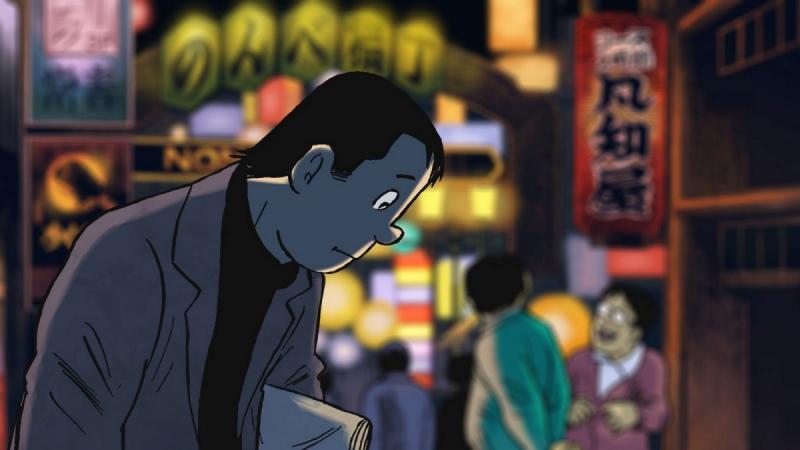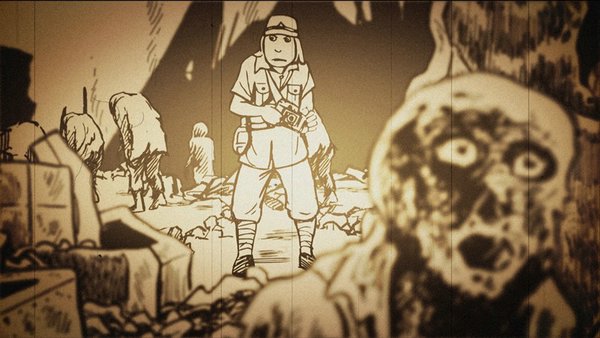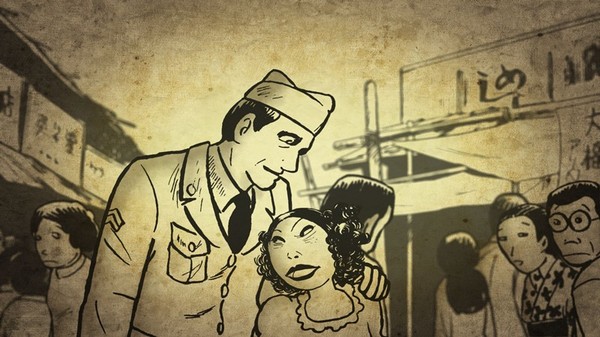Tatsumi | reviews, news & interviews
Tatsumi
Tatsumi
The life and stories of a revolutionary Japanese artist

The Western image of manga comes from the thick volumes of knicker-flashing schoolgirls and lurid s.f. teenage boys pore over, and the anime (cartoon films) which adapt them. Singaporean director Eric Khoo’s animated adaptation of five stories by Yoshihiro Tatsumi, framed by details from his graphic autobiography A Drifting Life, reveals a radically different medium.
 The 1970s stories here are almost unhinged in their driven potency. “Hell” follows a Japanese military photographer through shattered Hiroshima (pictured above). The photo he takes of an ash-shadow on a wall, all that remains of a son lovingly massaging his mother’s back, becomes his route to fame, national honour and fortune. Statues are erected of his image, foreign tours arranged. But the wheezing, masked figure haunting Hiroshima’s ruins would like a word...
The 1970s stories here are almost unhinged in their driven potency. “Hell” follows a Japanese military photographer through shattered Hiroshima (pictured above). The photo he takes of an ash-shadow on a wall, all that remains of a son lovingly massaging his mother’s back, becomes his route to fame, national honour and fortune. Statues are erected of his image, foreign tours arranged. But the wheezing, masked figure haunting Hiroshima’s ruins would like a word...
“Good-bye” (pictured below) similarly pokes in the guts of Japan’s immediate postwar humiliation, as a woman services hulking GIs in her shack, and her father, still in the defeated Imperial Army’s uniform, hangs around for scraps of cash from her table. Both stay drunk, till the daughter decides on an act of such horrific transgression, it cancels every previous shame. The other, equally strong stories deal with sweating, overwhelmed salarymen, desperate for sex or some sort of way out from a regimented society, but doomed in imaginatively twisted ways not to find it.
 The animated versions of Tatsumi’s black-and-white panels have a jerky, brutal energy, gouting red blood when his protagonists stumble into sudden moments of full, screaming horror. The Western equivalent would be the 1950s EC horror and war comics, which caught so much of America’s postwar psyche in grimly elegant panels. The regulation twist endings of Tales from the Crypt and the like were risqué enough for the comics to be banned, after a public outcry at their effect on kids in the era of the McCarthy witch-hunt, neutering the mainstream art form in the US for decades. But they can’t compare with the genuinely adult themes Tatsumi powers his pulp fiction with, or the hysterical national and personal truths they fling at the viewer. These are not distanced literary works, they spring from somewhere more chaotic and hot-blooded, just about corralled by Tatsumi’s artistic intelligence. It’s no surprise to learn that postwar Japan’s most mercilessly iconoclastic writer, Yukio Mishima, was a fan. Khoo and animation overseer Phil Mitchell give them all rough life.
The animated versions of Tatsumi’s black-and-white panels have a jerky, brutal energy, gouting red blood when his protagonists stumble into sudden moments of full, screaming horror. The Western equivalent would be the 1950s EC horror and war comics, which caught so much of America’s postwar psyche in grimly elegant panels. The regulation twist endings of Tales from the Crypt and the like were risqué enough for the comics to be banned, after a public outcry at their effect on kids in the era of the McCarthy witch-hunt, neutering the mainstream art form in the US for decades. But they can’t compare with the genuinely adult themes Tatsumi powers his pulp fiction with, or the hysterical national and personal truths they fling at the viewer. These are not distanced literary works, they spring from somewhere more chaotic and hot-blooded, just about corralled by Tatsumi’s artistic intelligence. It’s no surprise to learn that postwar Japan’s most mercilessly iconoclastic writer, Yukio Mishima, was a fan. Khoo and animation overseer Phil Mitchell give them all rough life.
Tatsumi’s autobiography in-between the stories can’t, of course, hope to compete in interest, and the artist’s insights into his work verge on the trite. But his struggles to support his parents as their marriage drifts apart, the rivalry of his sickly brother, and the fellowship he eventually feels with other young manga artists making their way in the 1950s are an instructive context. They are rendered in painterly colour, in contrast to his imagination’s harsh black-and-white printed world. His real triumph isn’t any individual story, but an image of a Tokyo bookshop, neatly divided into novels and manga, with its gekiga section behind a cool glass divide. This film should send us to those shelves, where an unguessed-at Japan waits.
- Tatsumi is on release from Friday, 13 January
Watch the trailer for Tatsumi
rating
Explore topics
Share this article
Add comment
The future of Arts Journalism
You can stop theartsdesk.com closing!
We urgently need financing to survive. Our fundraising drive has thus far raised £49,000 but we need to reach £100,000 or we will be forced to close. Please contribute here: https://gofund.me/c3f6033d
And if you can forward this information to anyone who might assist, we’d be grateful.

Subscribe to theartsdesk.com
Thank you for continuing to read our work on theartsdesk.com. For unlimited access to every article in its entirety, including our archive of more than 15,000 pieces, we're asking for £5 per month or £40 per year. We feel it's a very good deal, and hope you do too.
To take a subscription now simply click here.
And if you're looking for that extra gift for a friend or family member, why not treat them to a theartsdesk.com gift subscription?
more Film
 Steve review - educator in crisis
Cillian Murphy excels as a troubled headmaster working with delinquent boys
Steve review - educator in crisis
Cillian Murphy excels as a troubled headmaster working with delinquent boys
 Can I get a Witness? review - time to die before you get old
Ann Marie Fleming directs Sandra Oh in dystopian fantasy that fails to ignite
Can I get a Witness? review - time to die before you get old
Ann Marie Fleming directs Sandra Oh in dystopian fantasy that fails to ignite
 Happyend review - the kids are never alright
In this futuristic blackboard jungle everything is a bit too manicured
Happyend review - the kids are never alright
In this futuristic blackboard jungle everything is a bit too manicured
 Robert Redford (1936-2025)
The star was more admired within the screen trade than by the critics
Robert Redford (1936-2025)
The star was more admired within the screen trade than by the critics
 Blu-ray: The Sons of Great Bear
DEFA's first 'Red Western': a revisionist take on colonial expansion
Blu-ray: The Sons of Great Bear
DEFA's first 'Red Western': a revisionist take on colonial expansion
 Spinal Tap II: The End Continues review - comedy rock band fails to revive past glories
Belated satirical sequel runs out of gas
Spinal Tap II: The End Continues review - comedy rock band fails to revive past glories
Belated satirical sequel runs out of gas
 Downton Abbey: The Grand Finale review - an attemptedly elegiac final chapter haunted by its past
Noel Coward is a welcome visitor to the insular world of the hit series
Downton Abbey: The Grand Finale review - an attemptedly elegiac final chapter haunted by its past
Noel Coward is a welcome visitor to the insular world of the hit series
 Islands review - sunshine noir serves an ace
Sam Riley is the holiday resort tennis pro in over his head
Islands review - sunshine noir serves an ace
Sam Riley is the holiday resort tennis pro in over his head
 theartsdesk Q&A: actor Sam Riley on playing a washed-up loner in the thriller 'Islands'
The actor discusses his love of self-destructive characters and the problem with fame
theartsdesk Q&A: actor Sam Riley on playing a washed-up loner in the thriller 'Islands'
The actor discusses his love of self-destructive characters and the problem with fame
 Honey Don’t! review - film noir in the bright sun
A Coen brother with a blood-simple gumshoe caper
Honey Don’t! review - film noir in the bright sun
A Coen brother with a blood-simple gumshoe caper
 The Courageous review - Ophélia Kolb excels as a single mother on the edge
Jasmin Gordon's directorial debut features strong performances but leaves too much unexplained
The Courageous review - Ophélia Kolb excels as a single mother on the edge
Jasmin Gordon's directorial debut features strong performances but leaves too much unexplained

Comments
Tatsumi's genius stayed